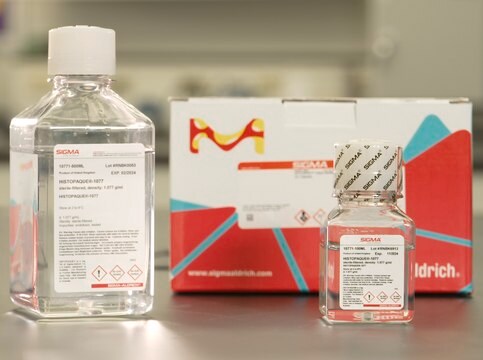3014-05A
Human Carotid Artery Endothelial Cells: HCtAEC, adult
About This Item
Prodotti consigliati
Origine biologica
human carotid artery (normal)
Livello qualitativo
Confezionamento
pkg of 500,000 cells
Produttore/marchio commerciale
Cell Applications, Inc
Modalità di accrescimento
Adherent
Cariotipo
2n = 46
Morfologia
Endothelial
tecniche
cell culture | mammalian: suitable
Malattie correlate
cardiovascular diseases
Condizioni di spedizione
dry ice
Temperatura di conservazione
−196°C
Descrizione generale
HCtAEC has been used to elucidate molecular mechanisms of cerebral aneurism caused by haemodynamic (sheer) stress and inflammation, which were shown to act through PGE2-EP2 and NF-κB signaling (Aoki, 2011). Demonstrating a link between inflammation and neovascularization, serum amyloid A, a biomarker of inflammation, increased expression of TNF, F3 factor, NF-κB and VEGF leading to activated migration, wound healing and tube formation responses in HCtAEC; these pro-angiogenic activities could be prevented by pretreatment with the multi-angiokinase receptor inhibitor BIBF1120 (Cai, 2013). Additionally, CD40-CD154 signaling between endothelial cells and T cells leads to a stress response in endothelial cells via activation of NF-κB and MAPK/SAPK pathways and induces down-regulation of APLN, while at the same time activating viral immune surveillance system involving TLR3, IFIH1, RIG-I, and RNASEL (Pluvinet, 2008).
Also, HCtAEC, along with human aortic (HAOEC), brachiocephalic artery (HBcAEC), coronary artery (HCAEC) and subclavian artery (HScAEC) have been used to demonstrate that not only blood vessels from different tissues are highly heterogeneous, they also interact differently with leukocytes during the inflammation response (Scott, 2013). The authors further showed that differential N-glycosylation of commonly expressed vascular adhesion molecules may be responsible for this heterogeneity, as well as for modulation of signaling under resting and activated inflammatory conditions. This also explains why specific vascular beds may be more or less susceptible to particular diseases or stimuli. Importantly, if cells from different sources were used, these results could not be convincingly validated due to a number of uncontrolled variables, such as age, race, genetic variability or life style choices of the donors.
Because of the complex heterogeneity that exists not only between different donors, but even between different vascular beds in the same individual, it would be prudent to confirm any new findings on primary cell lots coming from several different origins.
Origine della linea cellulare
Applicazioni
Componenti
Nota sulla preparazione
- 2nd passage, >500,000 cells in Basal Medium containing 10% FBS & 10% DMSO
- Can be cultured at least 10 doublings
Mantenimento delle subcolture
Esclusione di responsabilità
Codice della classe di stoccaggio
11 - Combustible Solids
Classe di pericolosità dell'acqua (WGK)
WGK 3
Punto d’infiammabilità (°F)
Not applicable
Punto d’infiammabilità (°C)
Not applicable
Scegli una delle versioni più recenti:
Certificati d'analisi (COA)
It looks like we've run into a problem, but you can still download Certificates of Analysis from our Documenti section.
Se ti serve aiuto, non esitare a contattarci Servizio Clienti
Possiedi già questo prodotto?
I documenti relativi ai prodotti acquistati recentemente sono disponibili nell’Archivio dei documenti.
Protocolli
Technical information for working with human carotid artery endothelial cells including thawing, subculturing and cryopreservation
Il team dei nostri ricercatori vanta grande esperienza in tutte le aree della ricerca quali Life Science, scienza dei materiali, sintesi chimica, cromatografia, discipline analitiche, ecc..
Contatta l'Assistenza Tecnica.



![Imidazo[1,2-a]pyridine 99%](/deepweb/assets/sigmaaldrich/product/structures/109/863/81ccb63f-07c6-4271-b317-1ba58979d455/640/81ccb63f-07c6-4271-b317-1ba58979d455.png)
